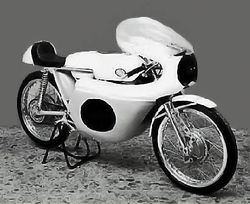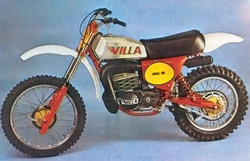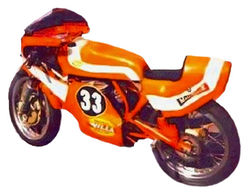Villa

Moto Villa (Moto Villa Francesco Villa, Modena, later Moto Villa in Monteveglio, Bologna and Pragatto de Crespellano, Bologna) and founded by Francesco Villa, was an Italian manufacturer that built models of cross-, terrain and race motorcycles.
This Italian brand was the brain child of the famous driver Francesco Villa, who - partly in collaboration with Montesa - from 1968, began with the production of his own motorcycles. It was mainly light crossers and racers. The first 125cc two-wegrace was developed on behalf of Mondial, which Villa himself began.
Born in Modena on the 5th February 1933, Francesco Villa merits a prominent place in the history of motorcycle racing, not only for the numerous successes he achieved as a rider, but also as a mechanic, preparer and constructor. He raced for more than a decade from the mid-fifties, and, after gaining the title of Italian Junior Champion in 1956 in the 125cc class, and second place in the 100cc class, he went on to win the Italian Senior Championship in 1961, '62, '63 and '64 on a 125cc Mondial. His career has been based on two main activities: that of a rider and that of "engineer", in the widest sense of the word. Francesco Villa started as a mechanic with Ducati in their "race division" that was directed by Ing. Fabio Taglioni, during that time totally dedicated to the production of a 100cc and 125cc SOHC named "Marianna", that was gaining brilliant results starting in 1955 at the Motogiro d'Italia, at the Milano-Taranto and numerous other competitions. Having already taken part at various contests and obtaining a second place at the Maranello-Serramazzoni Hill Climb on a 125cc Mi-Val, Ing. Taglioni included him in the race team as a rider. In the final classification of the 100cc class, Francesco gained second place at the Motogiro and the Milano-Taranto.
Second also at the Coppa U.C.M.I. at Imola and first at the circuit of Lugo, Rimini and Perugia. In 1956 he was again second at the Motogiro in the 100cc class at the shoulder of his teammate Gandossi and was adjudicated victor at a number of race circuits and hill climbs. At the end of the season he moved over to Mondial, where he was engaged more as a technician than a rider. He gained first place at the Aerautodromo di Modena in the 125cc class and third in the 100cc class. Again in 1957, at the Motogiro he won the first stage, Bologna-Riva del Garda, on a 175cc Mondial, and was second at the Circuito di Macerata with a 125 and the Viano-Baiso on a 250 cc. However, at the end of the season Mondial withdrew from racing, a decision taken jointly with Guzzi and Gilera. Francesco returned to knock on the door at Ducati, where he was greeted with kindness and employed at their competitions division, where the House of Borgo Panigale needed greater publicity, especially in the 125 and 175cc Sports class, events that created a market, as Ducati focussed on commercial successes principally in Spain and the United States.
In Italy he won at Messina and at Lago di Ganzirri with a 125cc Ducati. He was third at Monza in the G.P. delle Nazioni, which saw the debut of the new 125cc Twin, and first in the 175cc at the Trofeo Internazionale Sport. These summarize the results obtained in the 1958 season. A year later, in 1959, with the 175cc Ducati, he was first at Monza, Locarno and Florence. With the 125 he was first at Monza, Morciano di Romagna and Florence, and second at Riccione and Circuito della Favorita in Palermo. In 1960 with the Ducati 175 he gained four victories in the United States. He won the "24 hours" Montjuch (Spain), the Circuito di Morciano di Romagna and was second at the Circuito di Misano Mare. With the 125 he was first at Torino and Gallarate and second at Monza. In 1961, Count Giuseppe Boselli, incredibly passionate about racing, having now spent a reasonably long period of abstention from his close pact with Moto Guzzi and Gilera, believed he could put his "old" machines back on the track in the competent hands of Francesco Villa. This was a somewhat low-key return and certainly not backed by the vast resources at his disposal during the golden years.
1961 saw the start of this successful partnership; Francesco Villa refined and elaborated the "old" Mondial DOHCs, managing to make them competitive and to win the Italian speed title for three consecutive years. Technicians Melotti and Turicchi, from the former race division of Mondial, were made available to Francesco for the creation of a 50cc to compete in world championship races. The engine, a vertical single cylinder, DOHC capable of 7 bhp a 14,000 rpm, primary drive gear, multi-disc clutch and six-speed gearbox, was installed on a double cradle tubular frame, with telescopic front fork and rear swingarm, with a total weight of 50 kg and capable of 130 kph. The track debut took place in April of 1962 on the circuit at the Aerautodromo di Modena, Villa took first place. After this it took part in hill climbs, taking second place in the Campionato Italiano della Montagna. Mondial, although not officially taking part in races, prepared several machines to be sold to private individuals or to trusted riders, such as Francesco and his brother Walter. The Modenese rider-technician, at the time, had the great credit of being one of the first to grasp the potential of the modern school two-stroke engines with rotating disc distribution.
He forged a friendship with the German technician Peter Dürr, a great engineer and expert with two-stroke engines, and by the mid-sixties, with the 60cc class, Francesco prepared a single-cylinder two-stroke with cross current injection, primary drive gear, multi-disc clutch and four-speed gearbox. With a compression ratio of 11:1, power was around 12 bhp at 10,000 rpm. The frame, except for a few small changes, was the same as that of the 50cc, and allowed Mondial to show off this horizontal single-cylinder two-stroke that set in motion a series of successes, and with which Walter Villa, brother of Francesco, won the Italian title in 1965 and again in '66 and '67. Continuing in their unofficial capacity, in 1966 the Villa brothers in joint collaboration, after producing a few prototypes in 1965, presented two new 125 and 250cc motorcycles, both twin-cylinder two-strokes.
The new 125cc, equipped with drum brakes, had an air-cooled engine, with rotating disc valve, capable of 30 bhp at 14,000 rpm, and replaced the previous single-cylinder model that developed "only" 23 bhp at 11.500 rpm. The 250cc model had a mixed cooling system, water for the cylinders and air to the cylinder head, a compression ratio of 11.5:1 and a power output of 48 bhp at 11,500 rpm. The 250 had a front-mounted disc brake. The cylinders of both these machines were flanked and inclined at 30 degrees.
However, in subsequent years, these two machines would make only the odd appearance at the race tracks. At the conclusion of his collaboration with Mondial, Francesco slimmed down his participation in racing to devote himself to new aspirations, with the idea of becoming a rider-constructor. In 1966, he came out on track for the first time at Riccione with the Beccaccino, a 125cc of his own construction, finishing in third place, he came second in the Coppa d'Oro Shell at Imola and first at Cesenatico.
He then sold the 125cc project to the Spanish company Montesa with whom he had reached a mutual agreement focusing on the development and production of engines, and as a rider rode them to success in several races, later becoming the exclusive importer for Italy. In 1966, Francesco was the Italian Senior champion in the 125cc class. The history of Moto Villa, destined in future years to achieve brilliant results both in Italy and overseas (championships in France, Britain and Canada), began in 1967 with the construction of two new 250cc machines, a single-cylinder racer for sale to private customers, and a four-cylinder. The 250cc had a two-stroke vertical single-cylinder engine with a compression ratio of 12:1, rotating disc valve and a power output of 40 bhp at 9,500 rpm, that generally followed the design of the previous 125cc project (Beccacino), with a seven-speed gearbox. The 250 four-cylinder engine had only a six-speed gearbox, in anticipation of the new IMF (International Motorcycling Federation) regulations due to enter into effect in 1970. The air-cooled cylinders were of a narrow frontal 'V' formation with rotating disc valves.
Unfortunately, this bike was built before the IMF took a decision to restrict, starting from 1970, the number of cylinders to two for the 250s, with a six-speed gearbox. The project had already been developed and as the bike was almost ready, Francesco wanted to go ahead and complete the project. Apart from the engine data: 43 x 43 x 4 (249,65cc), power figures and other data have never been fully disclosed by the manufacturer, and the machine made only a brief appearance at Monza in 1969 for a series of tests. Francesco Villa, who began his pursuits working on the preparation of a Mi-Val, could now be considered one of the most experienced technicians in the world of high efficiency two-stroke engines. From his small workshop in the Via Pistoia Vaciglio, on the outskirts of Modena, he continued to work and experiment on new solutions for two-stroke engines of varying displacements, gradually moving away from the race circuits and veering towards off-road racing and motocross, disciplines that had yet to be fully "explored".
And it was to these new disciplines that Francesco transferred the techniques and knowledge he had gained in the motorcycle racing sector, and prepared a few motorcycles for motocross, with the denomination CR, that in 1972, gained 36 successes in 38 races in the hands of Italo Forni. A stunning debut that went largely unnoticed in the journals of that time, who were more interested in the speed-race sector. In 1973 Francesco went ahead with the construction of new model, the CR, intended solely for competition riders, and equipped with engines of his own manufacture, some of which were also shared by other major manufacturers such as Carabela Mexico. This new direction, the production of off-road motorcycles, soon motivated Francesco to expand his business, building new and modern production facilities at Pragatto Crespellano, near Bologna. In these new and spacious surroundings (which became operational in 1974), production of Moto Villa, now almost entirely dedicated to off-road motorcycles, was very intense. This was due to Francesco's approach which focused on hard work, the manufacture of products of the highest quality, in an environment where employees could work in optimal conditions.
Into production came the new FV series of motorcycles, with 125, 250, and 360 cc engines, available in versions for both Motocross and Enduro/Time Trials, with an engine derived from the previous series and a previoucly unseen frame. All the motorcycles produced were from their initial conception designed for competition use: special chrome-moly chassis, Marzocchi or CorteCosso forks and shock absorbers, and other components in light alloy and fibreglass to limit weight, plus a very attractive design. The engines were single-cylinder two-stroke of modern design with cross-current distribution, aluminium cylinder and transistorised ignition. All had a five-speed gearbox, except for the 125cc which was fitted with a six-speed. The primary transmission was gear driven and the clutch multi-disc in oil-bath. The bikes were sturdy, well made, with attention to detail, very competitive and above all very beautiful. The FV series was a huge commercial, as well as competitive, success for Moto Villa, and with the FV, Moto Villa won the Italian 250cc Cross Cadet championship in '75, '76 and '77, confirming Moto Villa as an emerging force and important in the view of off-road motorcycle manufacturers. In this range, Moto Villa also put into production a small number of "baby moto" with 50cc two-stroke engines and single-gear transmission with a centrifugal clutch and, for those more experienced, a "minicross" with a four-speed gearbox. Production and development of racing motorcycles also continued production, and in 1974, the Modenese Claudio Lusuardi on a Villa became Italian champion in the 50cc GP class. Following on from the FV series, another successful dynasty of off-road motorcycles went into production, which was also offered in two versions Motocross and Enduro/Time trials: the MX series. Equipped with air-cooled single-cylinder engines with displacements of 125, 250, 350, 410 and 480cc, improved handling, lightened, and having a greater amount of detailing made from composite materials, the MX series of bikes were also well received by the public. Another masterpiece by Francesco Villa.
Meanwhile 1978 was yet another glorious year, it was the year of the victory in the Italian Senior Motocross Championship for the 500cc class, with Franco Picco, ahead of Maddii and De Petri. It is impossible to list all the successes gained during that period both in Italy and overseas in the 250cc, 350cc and 500cc class with Picco, Boano, De Petri, Nani and the Dutchman Verstagen. Moto Villa was again Italian Champion in 1980 with Claudio Lusuardi in the 50cc GP class and in 1982 with Luca Cadalora in the 125cc TT4 class. Success also came in Karting (for which Francesco devoted a small production line producing specific engines), in Italy with Nizzoli in the 125cc class and in France with Blanchart. In 1983 it was again Lusuardi who claims the title of Italian Champion in the 50cc GP class, and Gibertini who won in the 125cc TT4 class. Following the MX series, and the subsequent MX1 and MXA (where A stood for water-cooled), into production came the MC (Motocross) and the EMS series (Enduro/Time trials) with engines ranging from 80cc to 495cc. As well as all this, nevertheless, Francesco Villa, who had never lost his simplicity and modesty, tirelessly provided technical advice to a host of companies, some celebrated, also collaborated in the creation and development of projects such as the Lamborghini 3500cc F1 engine of Ing. Forghieri.
From the late '80s, however, the company's business was heavily influenced by the diminishing motorcycle market and increased competition from the industrial motorcycle giants, especially those from Japan.For a small operation like Moto Villa there remained little room in the market and along with enormous difficulties, including economic, production practically came to an end. But Francesco has never stopped working and providing advice, the latest of which was for a major Malaysian motorcycle company and an emerging Italian group.
In an "off limits" corner of the warehouse, where the prototypes are set up, they continue to experiment on new solutions for two and four-stroke single-cylinder engines and above all providing help to those wishing to undertake the restoration of one of his creations, putting at their disposal its still well-stocked spare parts warehouse.
Recently Francesco Villa signed an agreement with Daniele Neri, a great Modenese fan, that included the sale in favour of the latter of the motorcycles and spare parts of the Moto Villa Italia race team. Under the terms of the agreement, Daniele Neri is committed to organize a race team until Moto Villa Italia can once again be officially represented on the race tracks for the Classic Motorcycle Championships and so continue their vocation, meanwhile Francesco Villa, for his part, has made himself available for the preparation of the motorcycles of the new team. And it is from this premise that A.D.M. Corse was born, and it allows Moto Villa many winnings again on Classic Motorcycle Championships tracks. Moto Villa with ADM Corse won 2007 – 2008 and 2009 Italian Classic Motorcycle Champioship in the hands of Marco Ferrari, Vendemmia Stefano, Gianluca Gallingani, Orbati Alessandro and Franco Ulivi.
External Links
Send what you have to:
| Motorcycle Information and Photos by Marque: A - B - C - D - E - F - G - H - I - J - K - L - M - N - O - P - Q - R - S - T - U - V - W - X - Y - Z |
| Car Information and Photos by Marque: A - B - C - D - E - F - G - H - I - J - K - L - M - N - O - P - Q - R - S - T - U - V - W - X - Y - Z |


